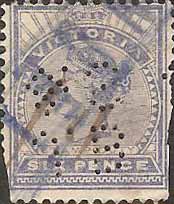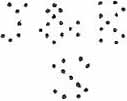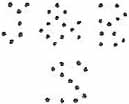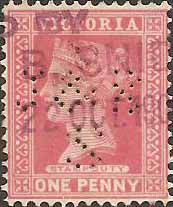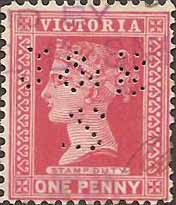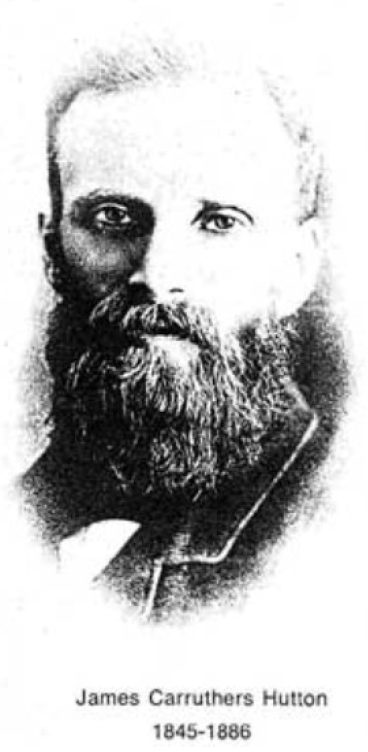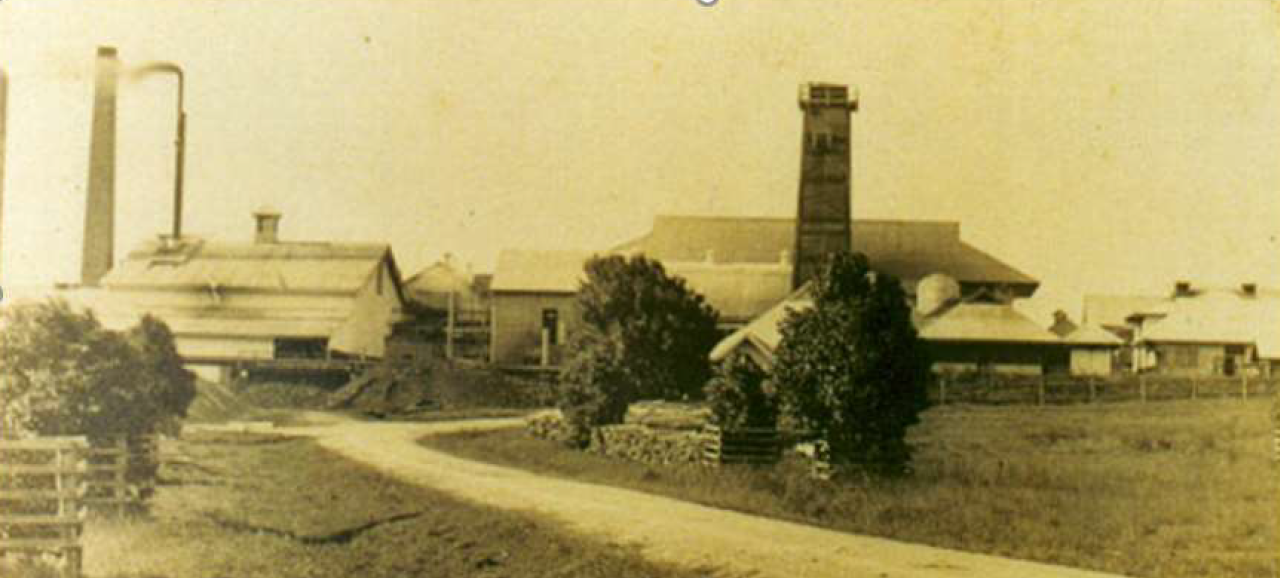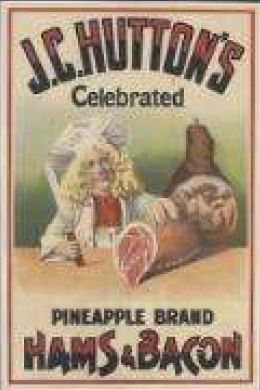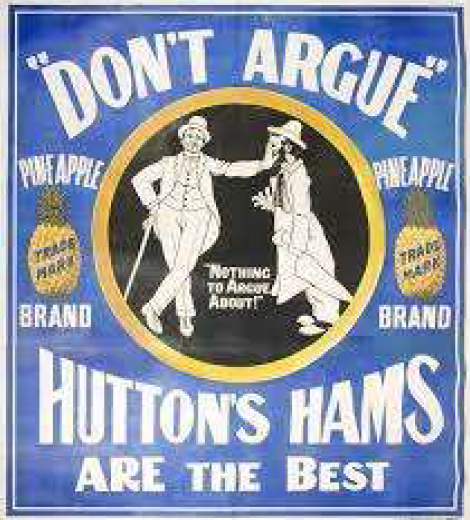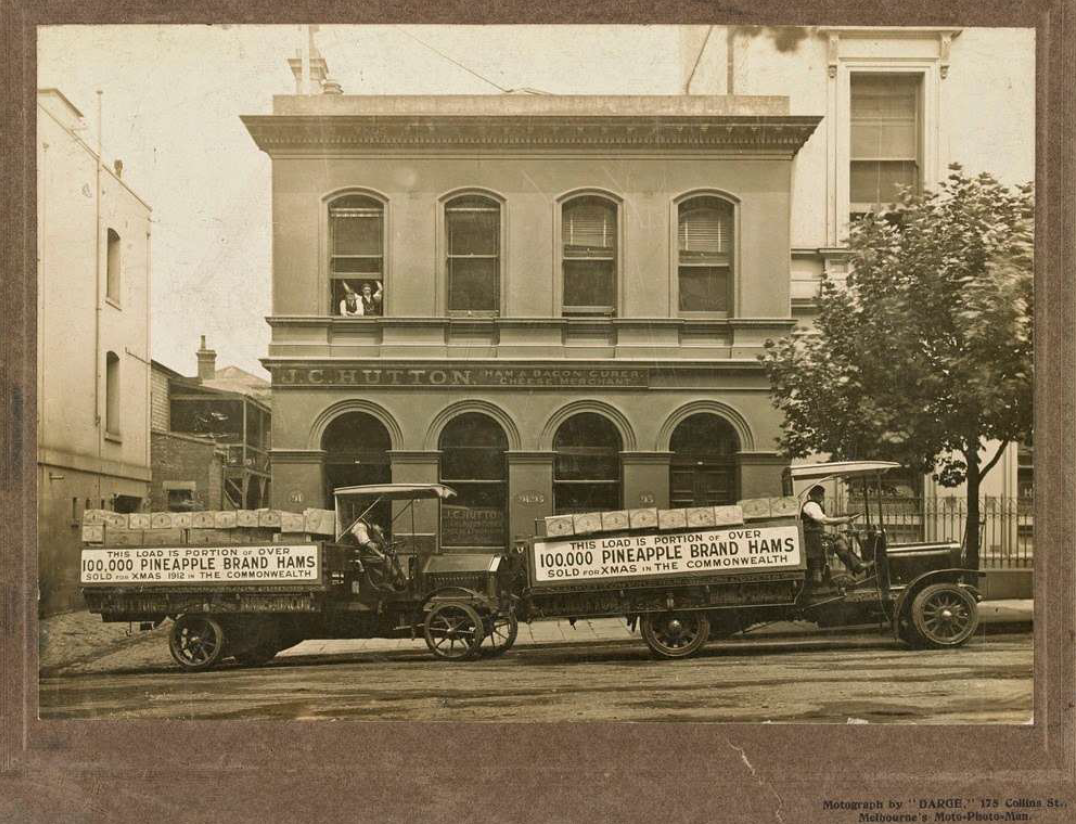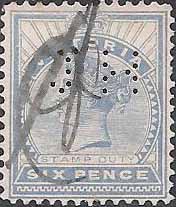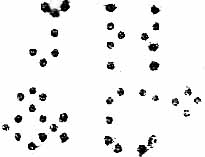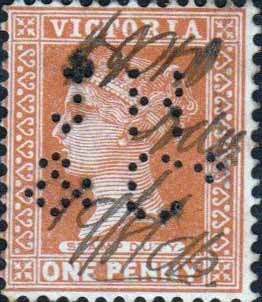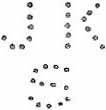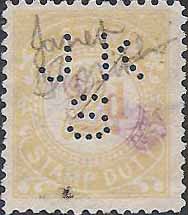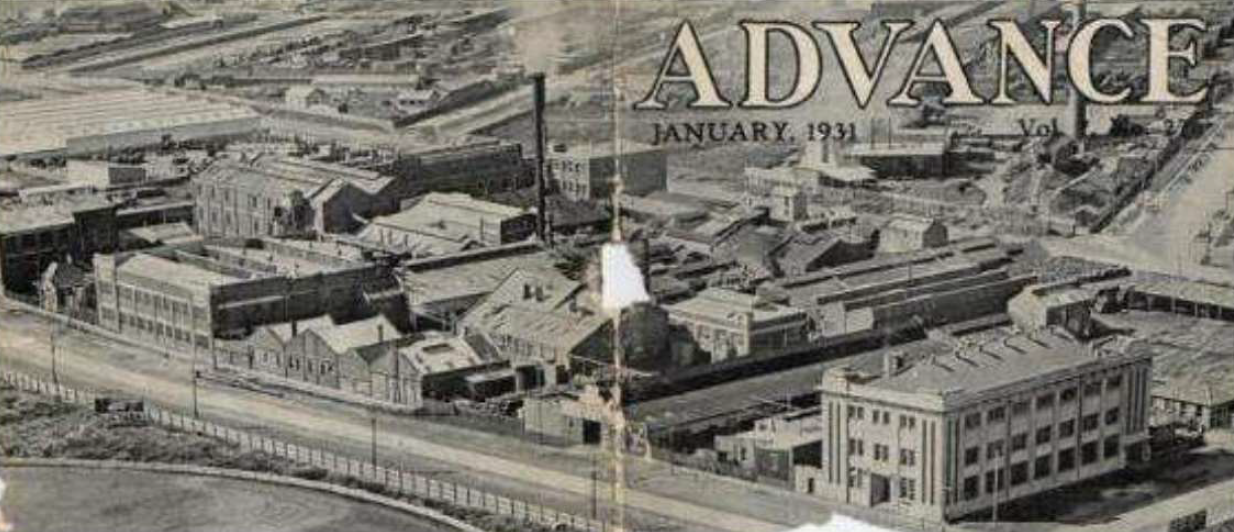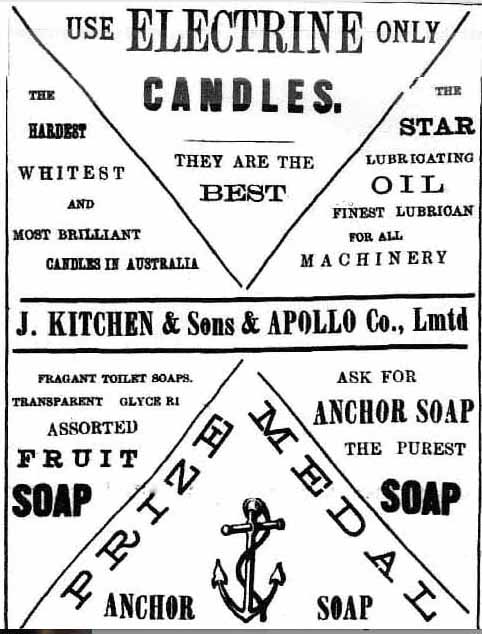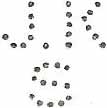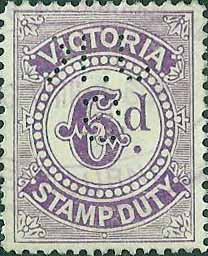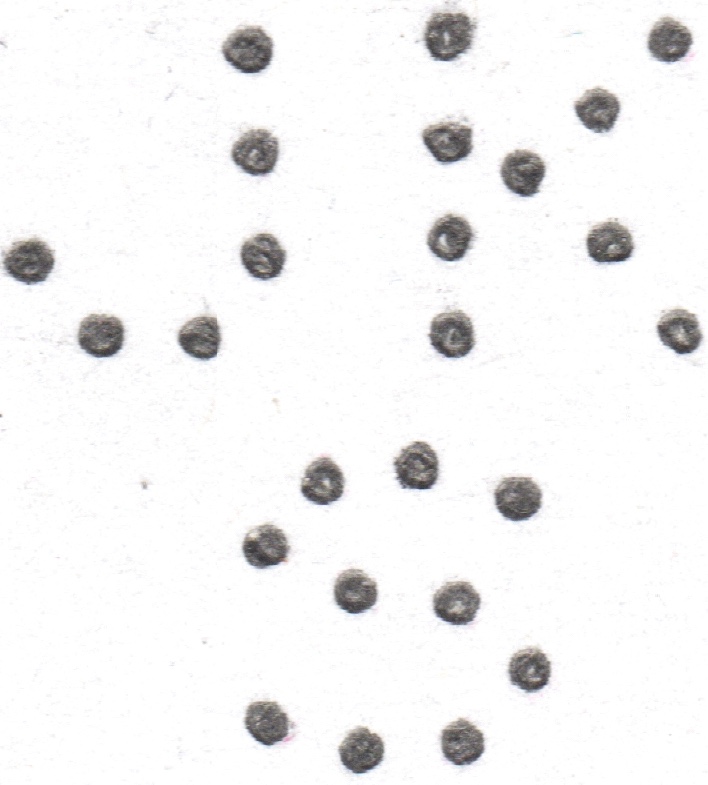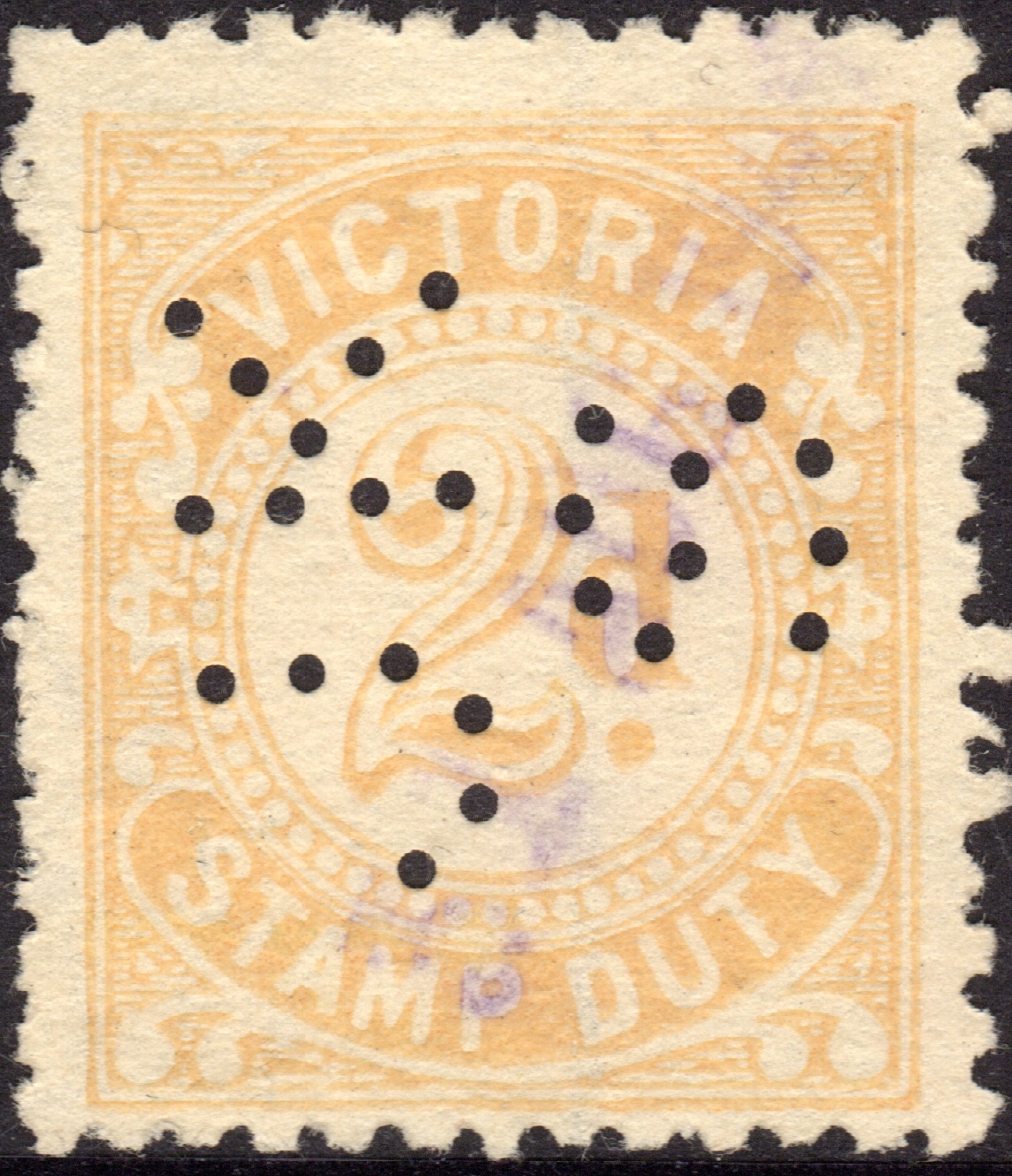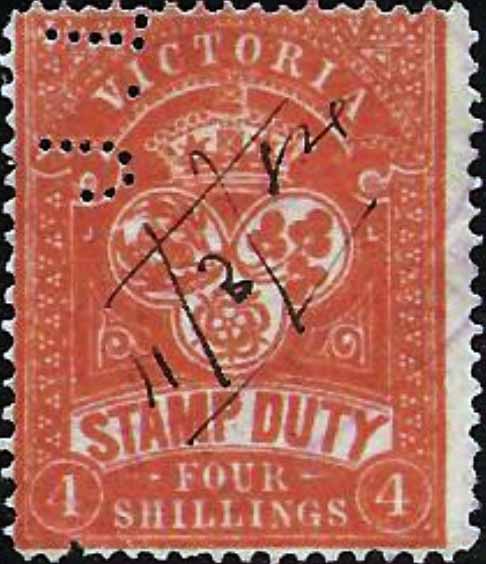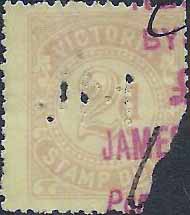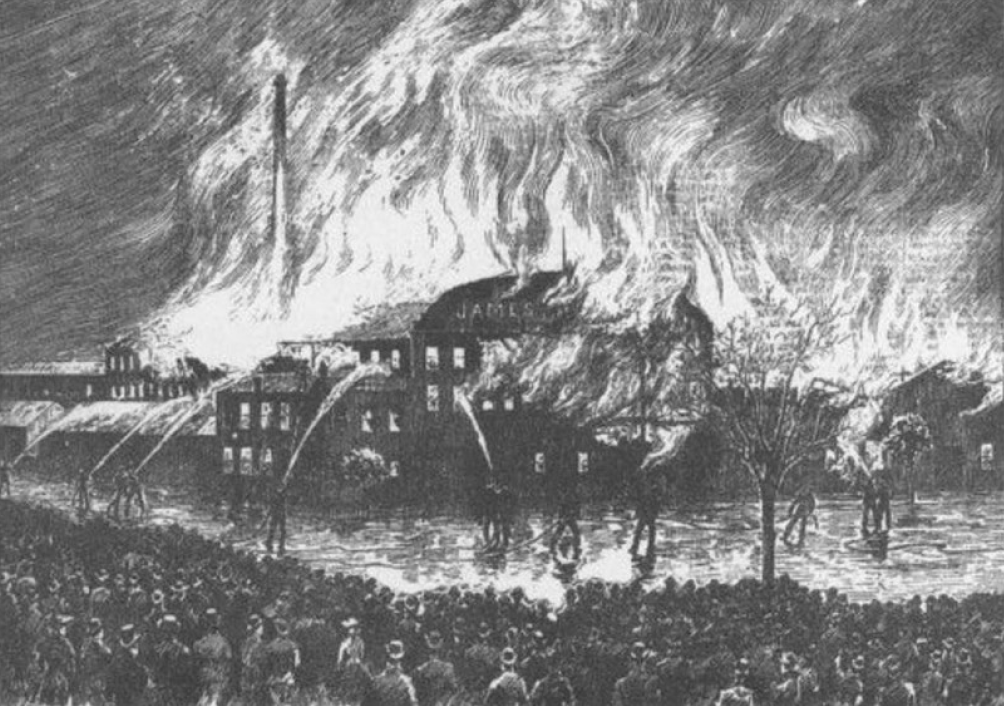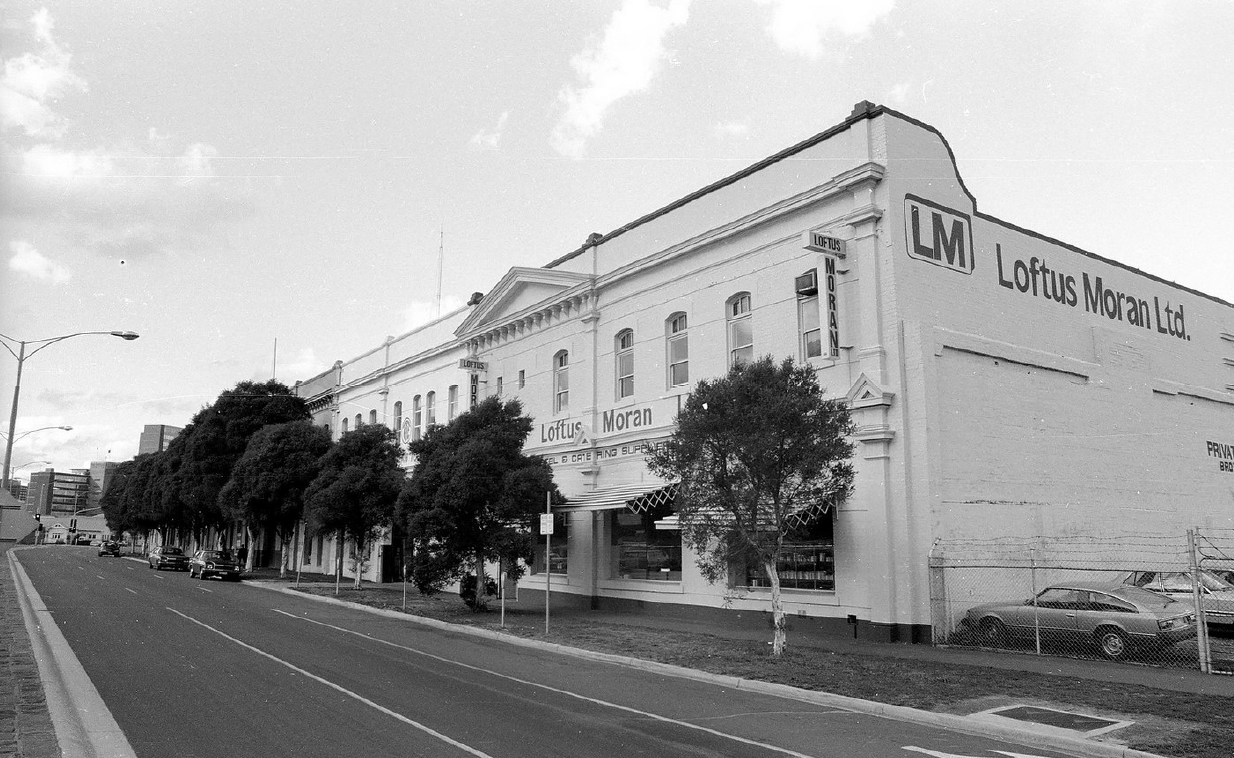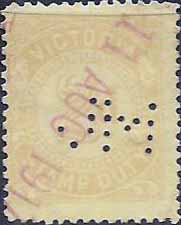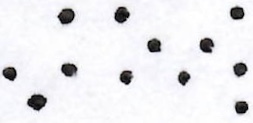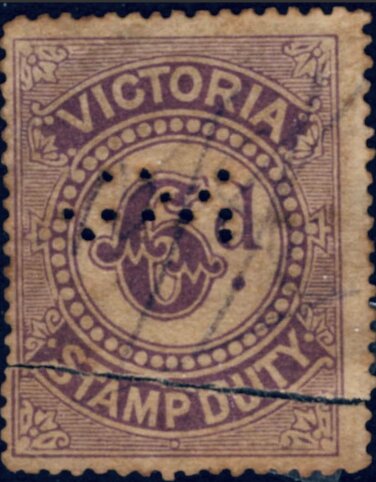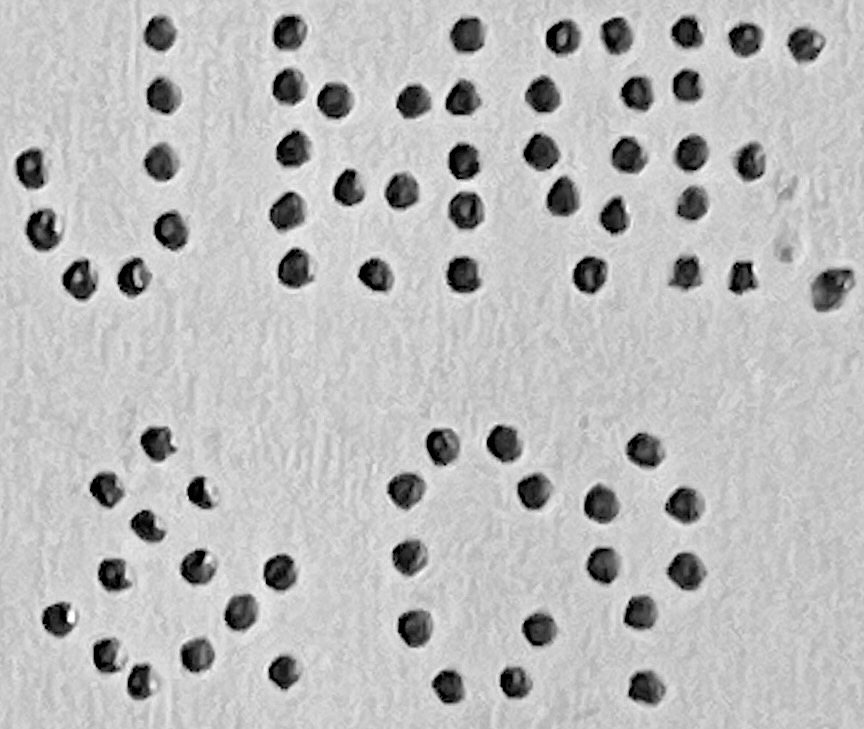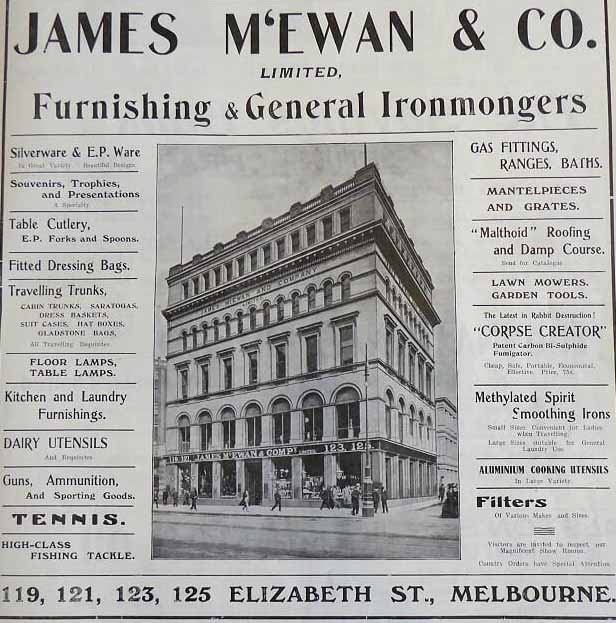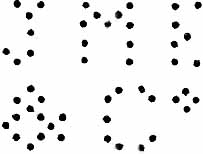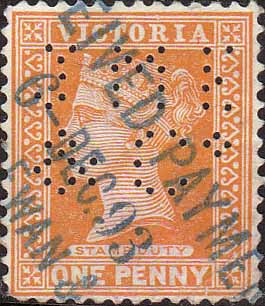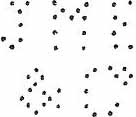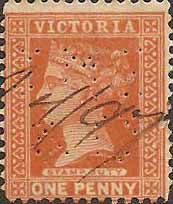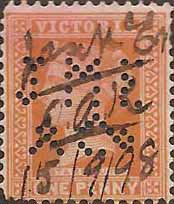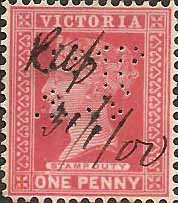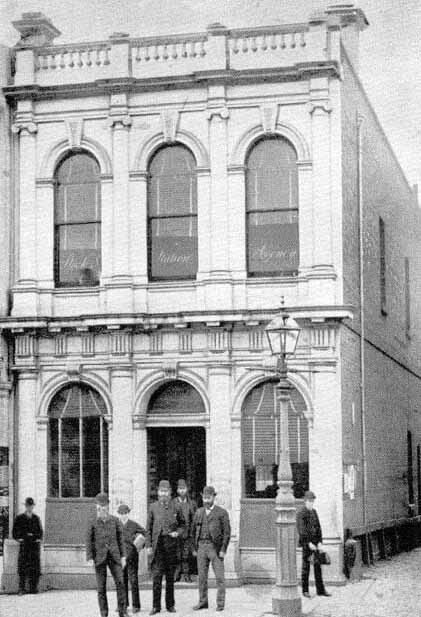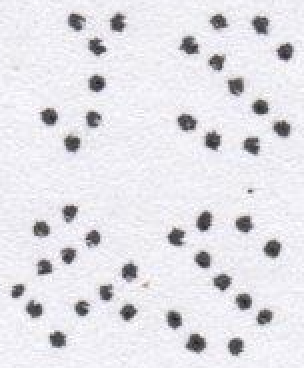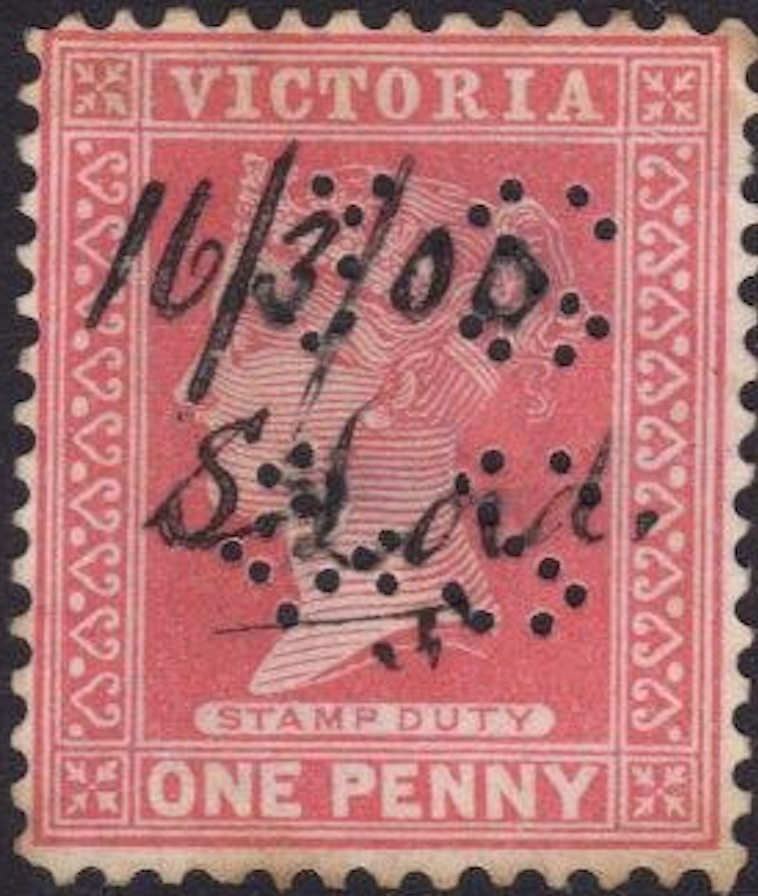|
Private Revenue Perfins of Victoria An Elsmore Coath production The authors would welcome your comments additions or input into this work A B C D E F G H I J K L M N O P Q R S T V W Y Other J -------------------------------------------------------- J.B/&S.a
User: J Bartram & Son Dairy Equipment Manufacturers and Dairy product merchants Address: 18 Queen St., Melbourne, VIC. From about 1899:
19-23 King Street., Melbourne, VIC. Revenue Use: 1886 - 1899 Series,
inscribed 'STAMP DUTY' 6d Rarity
Scale: 1886-1899 Series 6d R4
Background: #Jabez Bartram was born in 1826 in Bedfrshire and migrated to Victoria shortly after his marriage to Anne Haworth in 1848. In 1860 Jabez Bartram is found at Macedon Bakery in Riddell's Creek where he was a resident, standing for election (unsuccessfully) as a ("gentleman") candidate for West Bourke in 1871.
In
1888/9, Bartram & Son patented and were the
sole manufacturers of the Eureka Butter Printer
and Weigher, a machine which enabled 45 pounds of
butter to be cut and shaped into half pound (or
any other weight) rolls. In 1889, the company was
the Department of Agriculture selected consignment
agent for all Victorian butter for the London
market, the Department having already secured all
available shipping space.
Danish butter realised higher
prices in London than Victorian butter and in order
to "all Victorian butter makers on an equal footing
with the Danish competitors" Bartram & Son, in
1894, acquired the services of Mr Olsen who had
"long and practical experience of butter making in
both Denmark and Sweden".
J. Bartram & Son became "Pty Ltd", in 1912, and moved to 586 Bourke Street. The company was still trading in 1955. Jabez Bartram died in 1880 (age 54) at his home in Kew, leaving an estate valued at £860. Haworth William Bartram, principal of J. Bartram & Son Pty Ltd, died in London in December 1918. Device: The JB/&S. a device was a single die customised device and this is proved by multiples which show no consistent relationship between strikes. The device came into service in 1894 and remained in use until at least 1908 when it appears to have been replaced by a similar looking device which was only in use for a short period. The withdrawal and replacement of the JB/&S. a device is difficult to fathom as it seems to have been in a sound condition and examples seen on postage stamps from 1907 and 08 show it is still producing clear and complete strikes. The pattern is common on postage stamps but very rare on revenues stamps where its usage is restricted to the pre 1901 period in which Victorian postage stamps were valid for use as revenue stamps. Related Patterns: Nil #Trove, Jenny O'Donnell Research -------------------------------------------------------- J&B/S.a
User: J & B Sniders General merchants Address: 36-50 Flinders La, Melbourne, VIC. Revenue Use: 1886 - 1899 Series,
inscribed 'STAMP DUTY' 6d Rarity
Scale: 1886-1899 Series 6d R4
Background: *The antecedents, of
J. & B. Snider are found in 1860, in William
Marrett, trading in china, glass and earthenware
from premises at 156 Bourke St East. Joseph Marrett
and William Marrett, of Marrett Sniders & Co.,
were trading from 195 Flinders Lane East in 1863, at
the same time as Marrett and Sniders were trading
from 156 Bourke St.
By November 1865, when the business move to a two storey brick building at 127-129 Russell St. Marrett had taken either Joseph or Barnett Sniders into partnership, the firm trading as Marrett, Sniders & Co. In 1868, Marrett ceased to be involved in the business. By 1880, the firm, still located at 127-9 Russell St, was known as J(oseph) & B(arnett) Sniders (the resident partner), importers of china, glass, and earthenware, with "the largest stock in the colony". The firm also imported cutlery and ready-made clothing and ran a boot shop at 206 Bourke St. J. & B. Sniders advertised as "agents for J. Schneiders & Sons, 27 Commercial St, London, and in 1886 as having a branch in Charlotte St, Brisbane, with the London offices at Buck's Row. In July 1885, J. & B. Sniders held a series of massive clearance sales of leading china ware makers - Minton, Wedgewood, Limoges-preparatory to moving to newly renovated and outfitted freehold premises at 177-181 Flinders Lane, "next to new Masonic Hall". In August 1903, J. & B. Sniders occupied premises at 36-50 Flinders Lane. The business consisted of the five brothers-Joseph Snider, Michael Schneider, Henry Schneider, Louis Schneider and Barnett Snider. A(braham) Schneiders was still operating a business from 50 Flinders Lane in 1950. While, in 1909, the lower floors of the building were occupied by J. & B. Sniders, the upper floors were used as the clothing warehouse and factory of Sol(omon) Schneiders & Son, which was incorporated in J. & B. Sniders. While the premises at 48 Flinders Lane would continue to be occupied until 1925, both businesses re-located in March 1911, J. & B. Sniders to 318-324 Flinders Lane and S. Schneider & Son to Gordon Place, rear Princess Theatre. In July, tenders were called for the erection of an additional story to the new Flinders Lane warehouse. In 1922, the Flinders Lane building (between Collins Place and Spring Street) was demolished and two new six storey concrete buildings (40'x 100' each) were erected and leased out (apply J. & B. Sniders 318 Flinders Lane). J. & B. Sniders gave up the clothing portion of their business in Flinders Lane in March 1925, selling all the machinery and plant. In August 1925, the building at 318 Flinders Lane comprising "warehouse, showrooms, ground, second and third floors, goods and passenger lifts" was put out to lease. Barnett Sniders left Melbourne in September 1904, for England where he died in August 1909, at the age of 58. A man of "large and liberal character", he was involved in many Jewish philanthropic associations and was, for many years president of the Melbourne Jewish Philanthropic Society. He was also involved in the management of the Melbourne Hospital, represented the Earthenware. & Crockery Importers Association and was a prominent member of the Victorian Chamber of Manufacturers. 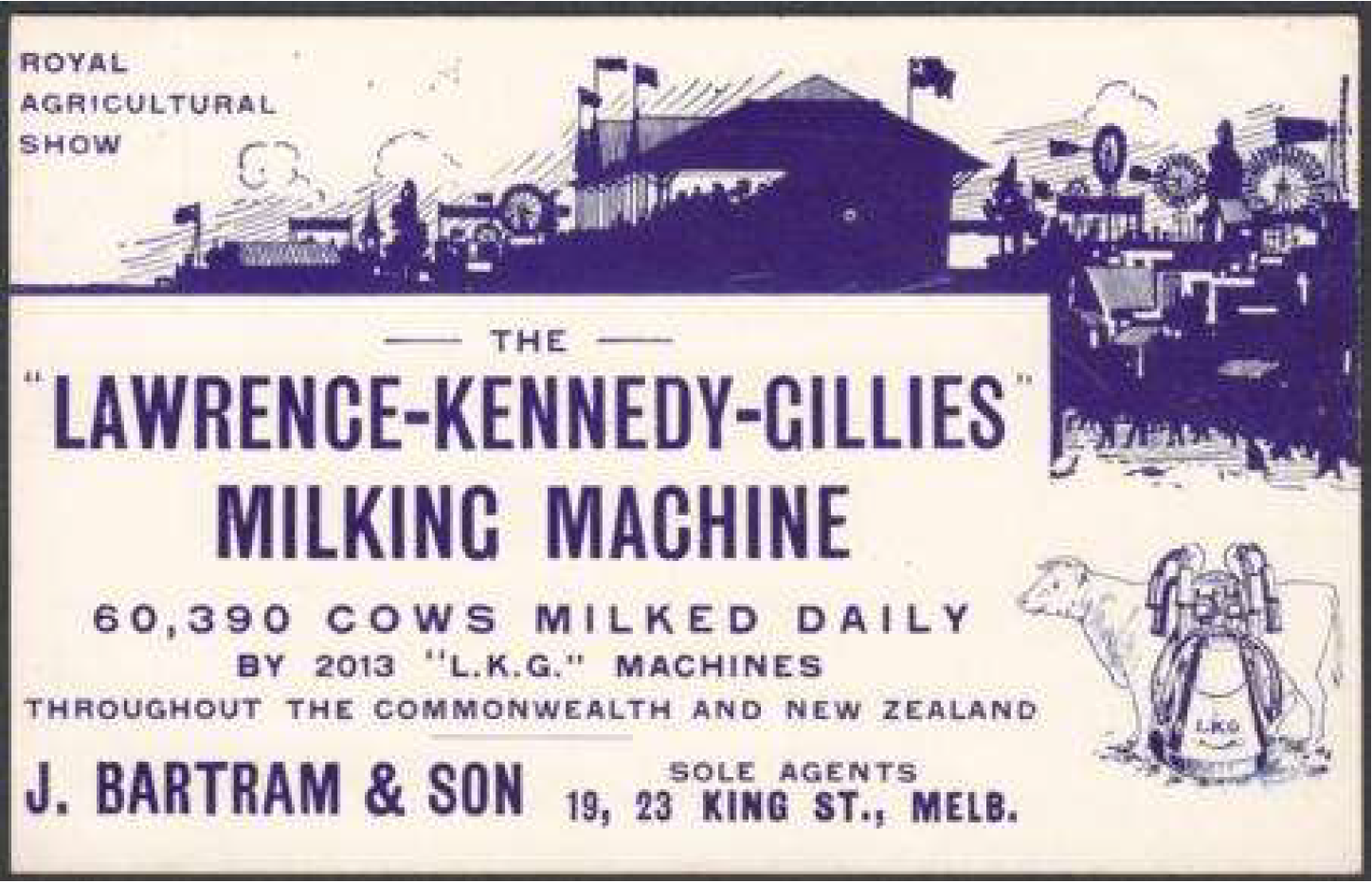 Device: The J&B/S.a pattern was produced on a single die temporary device of the style used by Stamp Vendors. These devices had a punch head with a grid of holes that allowed pins to be loaded into it, in order to create many patterns. The user J. & B. Sniders is known to have been party to an application to perforate stamps made by the stamp vendor Edward T Moulden in 1893. However, the earliest usage of J&B/S patterns does not occur until later in 1896. The J&B/S.a pattern dates from 1896 and is found in 12 or more various forms with variations in letter locations for the period 1896 until 1900. The company had a myriad of patterns produced by Temporary devices and at least 35 J&B/S patterns as well as 6 JBS patterns are either proved or provisionally assigned to J. & B Sniders over the period 1896 until at least 1927. The company even had its own customised device that was in use from 1912 until 1921 but they mainly used Temporary patterns. Revenue use is limited to the period before 1901 when Victorian postage stamps could also be used as revenue stamps and only 2 patterns from the array of J&B/S are found with revenue usage. Related Patterns: VIC: J&B/S.b * Jenny O'Donnell Research -------------------------------------------------------- J&B/S.b
General
Merchants Address: 36-50
Flinders La, Melbourne, VIC Revenue Use: 1886-1899
Series, inscribed 'STAMP DUTY' 1d (shades) Rarity
Scale: 1886-1899 Series 1d R4 Background:
See j&B/S.a, above. Device: The
J&B/S.b pattern was produced on a single die
temporary device of the style used by Stamp
Vendors. These devices had a punch head with a
grid of holes that allowed pins to be loaded into
it, in order to create many patterns. J&B/S.b is
quite a large format of pattern and came into use
in 1900 and was produced over the period 1900-1927
in about 18 different settings that had the same
scale and layout of letters but the placement of
the letters in relation to each other varies. Related
Patterns: VIC: J&B/S.a -------------------------------------------------------- JCH.a
User: J C Hutton & Co Ham & Bacon Curer, Cheese & Provisions Address: 91-93 William St, Melbourne, VIC Revenue Use: 1915 Series: 2d Rarity Scale: 1915 Series 2d R4 Railway Scale:
1934 issue 8d, 1/- Railway Use: 1934 issue 8d R4,
1/- R4 Background: #
James Carruthers Hutton (image below) was born in
1845 in Yorkshire and emigrated to Victoria as a
child with his family in the 1850s. James
Carruthers Hutton, his brother Colin Ferguson
Hutton and Samuel K. Grimes, bacon curers, were in
partnership in Northcote in April 1872. The
partnership was dissolved on 12 December 1873,
continuing as J. & C Hutton. (Samuel Grimes
continued in a separate bacon curing business.) By
July 1874, the firm, now advertising as "general
provisions curers, moved premises to Moreland
Road, Coburg. In 1879, Colin Hutton appears to
have left the firm which became J.C. Hutton &
Co. (Colin Ferguson Hutton, brother of J.C. and
William Hutton, died in 1903, aged 56 years).
In 1882, John Reid, who had worked for J.C. Hutton since 1877, opened an agency of the company in Fortitude Valley (Brisbane). By November 1882, the J.C. Hutton factory had moved from Coburg to Preston (in Melbourne), with offices at 9 William Street, corner of Flinders Lane, Melbourne. The company was among five in Victoria (advertised by the supplier) which, in 1883, installed the latest "cold dry air machine" or "refrigeration machine" (for meat cooling). James Carruthers, Hutton, provisions merchant of Melbourne and Preston, eldest son of James Hutton late of Prahran, died in October 1886, at the age of just 41 years. In 1888, J.C.
Hutton & Co. acquired (initially) 113 acres of
land at Zillmere, near Brisbane, and built a ham
and bacon factory which was opened in 1889 by John
Reid who was the manager. (See below) This John Reid
would be instrumental in the development of the
"Pineapple" brand and the famous "Don't Argue"
trademark. (See images below) In 1897 the company
opened another branch in Townsville. Reid became
Managing Director of the company in Queensland in
1907. The Zillmere plant (by then 250 acres)
closed in 1965 and was demolished.
“Pineapple
Brand” and “Don’t Argue”
In 1907, the firm converted to a proprietary company, J.C. Hutton Pty Ltd, and later moved to its new 91-93 William Street offices. (See above) At about this time, Colin Hutton, (born 1872) became Managing Director of the company, a position he retained until his premature death at his home, 'Combee', in Preston in August 1914 at the age of just 42.In late 1926, the company moved to 34-38 King Street, Melbourne, The company history becomes rather unclear after this time with Hutton'slocated in plants in Canterbury (NSW), Zillmere (Qld), as well as Townsville, Preston (Melbourne) and later New Zealand. The company splintered somewhat in the mid to late 1920's with Foggitt Jones (a fellow perfin user) purchasing some of the Queensland operations, which were then on sold after World War 2. There were many instances of company's names such as Hutton's, Hutton's Smallgoods etc. but they were almost unrelated to the original company and the Hutton Family. Device: The JCH device was a single die customised one, that came into service in about 1906. Oddly Victorian postage usage is not all that common and the JCH pattern is most common on the 1d Red KGV and Kangaroo and seems to have been used almost exclusively on letter rate mail. Usage continues until 1936 and Postmarks are almost exclusively Melbourne, which is consistent with the Head Office location at William Street and later King Street. Usage on revenue duty stamps is unreported, but we know that the pattern was applied, rarely, to Victorian Railway stamps. Most of these are on the 1934 "Wings" series and the values of 6d, 1/- and 2/- are known. However, some values are also reported on the 1917 Series. The JCH device
features rather thick holes, and the pattern is
generally consistent over the usage period, so it
is hard to say why it was discontinued. Perhaps it
was a victim of one of the structural changes to
the Business or the changes in Postal services,
like franking. Related
Patterns: Nil # John Oxley
Library, Jenny O'Donnell Research, Trove -------------------------------------------------------- JD/S.a
User: J Danks & Son (unconfirmed) Engineers Address: 391-403 Bourke St, Melbourne, VIC Revenue Use: 1886-1899 Series, inscribed 'STAMP DUTY' 1d (Shades) Rarity Scale: 1886-1889 Series 1d
R4 Background: #John Danks was born in Staffordshire in January 1828, the son of a gas tube and wrought iron manufacturer. Described as an "engineer" on the ship's passenger list, he immigrated to Victoria aboard the "Shaftesbury' arriving in November 1857. Included in the family party were his wife Ann, his four small children (all under the age of 3), and his sister Sarah and his brothers Sam (aged 26) and Thomas (aged 18). After a number of unsuccessful ventures, Danks Bros, in 1859, opened a small shop at 34 (renumbered to 42) Bourke Street, opposite St Patrick's Hall, selling fittings for engineers, plumbers, gas-fitters and water supply. (The business would continue to occupy the same site for a century.) One of their first contracts was for pipe connections for the new Yan Yean water supply. Thomas Danks retired in 1860, and
the firm continued as J. & S. Danks. In 1871,
when Samuel retired, John Danks established works at
City Rd, South Melbourne. A branch shop for the sale
of manufactured products was established in Sydney
in 1881, followed by a large-scale manufacturing
plant in 1893. A branch shop was also established in
Christchurch, New Zealand. The company manufactured boilers and small steam engines among its many products and continued to introduce new products, a number patented to John Danks himself, ("an ingenious gas burner" motor for tram cars, 1885; improvements to fire hydrants, 1889"). In 1887, the firm diversified into manufacturing lead sheet and pipe. The most familiar product manufactured by John Danks was the ubiquitous windmill seen throughout rural areas. In 1889 John Danks' only son, Aaron Turner Danks, was made a partner in the firm which became styled John Danks & Son Ltd. Aaron Danks specialised in brass casting and opened a subsidiary business in Staffordshire, England, where his father continued to hold land. In 1896, the firm won a major contract associated with the expansion of the City of Melbourne sewerage system and by 1900, John Danks & Son Ltd had 200 employees and capital of £300,000. When John Danks died at his South Melbourne home in March 1902, he was succeeded as Chairman and Managing Director by Aaron Danks. In turn, Frederick Danks succeeded his father, Aaron on his death in 1928. John Danks & Son was floated as
a public company in April 1950 and in 1951, John
Danks & Son Pty Ltd became a wholly owned
subsidiary of Danks Holdings Ltd which was
incorporated as a public company. At the time, the
company was operating retail and wholesale shops in
Bourke St, Melbourne, and Pitt St, Sydney as well as
manufacturing plants in both cities. These were all
phased out during the mid-1950s when the decision
was made to concentrate on distribution to
independent hardware retailers. In 1970 John Danks Holdings Ltd. became part of an Australia-wide chain of hardware retailers Australian Hardware Distributors Pty. Ltd., which comprised John Danks & Son, Pty. Ltd. of Sydney and Melbourne; Sandovers Ltd. of Western Australia; Colton, Palmer and Preseton Ltd, of South Australia, W. Hart & Sons, Launceston, Tasmania; Homecrafts (Tasmania), Hobart, Tasmania; and Brett and Co. Pty. Ltd., Queensland, This led to the establishment of the Homestead (hardware) marketing group in 1971. The Homestead brand expanded to include the hardware businesses, of Homesaver and Thrifty-Link in 1980. The Homestead and Homesaver groups were ultimately merged in 1993 to form Home Timber & hardware. In 1995 they launched Plants Plus Garden Centres with the aim of broadening the company's customer and product base. John Danks (1828-1902) was elected to the Emerald Hill (South Melbourne) Council in 1871 and served until 1880, including two years as mayor 1874-76. He was a founder and council member of the Victorian Engineers' Association, a founder and director of the Australasian and European Bank and a commissioner at the 1888 Paris Exhibition. He was "held to be a kind hearted, equitable employer, well known for his philanthropy which was "distributed in the thoughtful and un-ostentatious manner that characterised all his actions". He gave £3,000 to the Cecil Street Methodist Church and £500 to the Melbourne Hospital, as well as giving £100 to charities in later years on the occasion of his birthday. Note: The company name is sometimes stated to be "John Danks & Sons" but as you can see from this history John Danks had a single son, Aaron, so the actual name of the company at the time of the perfin use was 'John Danks and Son. Device: Now it is important to re state at the beginning of this section that the JDS pattern is not proved to John Danks & Son, but having said that, there are no other likely candidates in Melbourne at the time and Danks are the most likely users of the pattern group that includes, JDS 10 patterns circa 1895-1902, JD&S 10 patterns circa 1902 - 15, and JD 4 patterns circa 1915-17. All of these various JD, JDS and JD&S patterns were produced on a single die temporary device of the style used by Stamp Vendors. These devices had a punch head with a grid of holes that allowed pins to be loaded into it, to create many patterns. All of these were found on postage stamps of the period 1895-1917. The JDS pattern found used on a revenue stamp was of a relatively common layout that was used between 1898 and 1902. The example we have found is manuscript cancelled in 1899. Related Patterns: Nil # Jenny O'Donnell Research -------------------------------------------------------- JH.a
User: Unknown Address: St, Melbourne, VIC Revenue Use: 1886-1899 Series, inscribed 'STAMP DUTY' 6d Rarity Scale: 1886-1899 Series 6d R4 Background: Unknown Device: The JH pattern was produced on a single die temporary device of the style used by Stamp Vendors. These devices had a punch head with a grid of holes that allowed pins to be loaded into it, to create many patterns. This JH pattern has not been reported in any other study, but it is likely to be related to contemporary JHCo and JH&Co patterns which are found used in Melbourne circa 1898. Unfortunately, the user of these other patterns is unknown. Related Patterns: Nil confirmed -------------------------------------------------------- JH&CO.a
User:
Unknown
Address: St, Melbourne, VIC Revenue Use: 1886-1899 Series, inscribed 'STAMP DUTY' 1d (Shades) Rarity Scale: 1886-1899 Series 1d R4 Background: Unknown Device: The JH&Co pattern was produced on a single die temporary device of the style used by Stamp Vendors. These devices had a punch head with a grid of holes that allowed pins to be loaded into it, to create many patterns. This JH&Co pattern is likely to be related to contemporary JH and JHCo patterns which are found used in Melbourne circa 1898. Unfortunately like the JH pattern, the user of these other patterns is also unknown. Related Patterns: Nil confirmed -------------------------------------------------------- JK/S.a
User: J Kitchen & Son Ltd Soap & Candle makers Address: 10 Queen St, Melbourne, VIC Revenue Use: 1911 Series 1d Rarity Scale: 1911 Series 1d R4 Background: #John Ambrose Kitchen was born in Oxfordshire in 1835and as a young man worked as a solicitor's clerk. After his father, John's grocery business failed, he migrated to Victoria in 1854, followed soon after by his father and brothers, Phillip and Theophilus. In 1856, the family began making tallow candles in the backyard of their Emerald Hill (South Melbourne) home. They were ordered out, as an offensive trade, in 1858, moving to Sandridge (Port Melbourne) at the corner of what is now Crockford and Ingles. A fire in 1860 destroyed the premises but they were quickly rebuilt in Ingles Street and offices at 8½ (as peculiar as it sounds this is correct) Lt Collins Street East were opened in 1865. (In 1882, the whole area of 117 acres bounded by Ingles, Boundary and Woodruff Streets was transferred from the Crown to J. Kitchen & Sons.) By 1868, J. Kitchen & Sons' offices had moved to 3 Queen Street, and the firm proudly advertised as making "the only Melbourne made pure soap awarded a prize medal at the Inter Colonial Exhibition" (1867). In 1870, the firm bought Gossage
Brothers soap and candle factory in Footscray, to
which they transferred their boiling down works. In
1873, J. Kitchen & Sons, now of 28 Flinders Lane
West advertised as the patentor and manufacturer of
"Petroline" candles. The driving force in the firm was John Ambrose Kitchen, who established factory in Wellington, New Zealand, in 1876; and bought out competitors (Walter Carwardine of Sandhurst Soap & Candle Works, at Charleston Road, in Sandhurst (Bendigo), and in Echuca and Wangaratta in 1887. From 1877, J. Kitchen & Sons was associated with Apollo Candle Co Ltd, with J. Kitchen & Sons becoming incorporated in 1883. The merger with Apollo Candle Co Ltd was completed in 1885, J. Kitchen & Sons becoming the pre-eminent soap and candle maker in the eastern mainland with a factory in Brisbane and a half interest in Sydney Soap & Candle Co. Ltd. By now, J. Kitchen & Sons employed some 300 people at their Melbourne works, manufacturing candles, soap, rendered tallow as well as glycerine, washing blue, soda crystals and baking powder. In 1886, a boiling down plant was
opened in Sydney, and in 1887 the soap works of H.
Kiapproth & Sons in Sandhurst was purchased. By
1895, the firm had successfully introduced machine
milling to Australia. In 1894 however, the New
Zealand business was closed, partly because of the By 1902, the firm had moved into South Australia and Western Australia and began producing copra oil from a plantation in Milne Bay, Papua, in 1907. The familiar brand of Velvet soap was introduced in 1906 and Solvol in 1915; other products included Anchor laundry soap and Persil. As expansion continued, the firm's offices were relocated to 10 Queen Street in 1908, eventually occupying the whole building. In 1925, J Kitchen & Sons moved into a new Art Deco Administrative Offices Building on the corner of Ingles Street and Quin Street (no longer extant). (The building is now heritage protected.) In1914, J. Kitchen & Sons
merged with British based Lever Brothers, the
Kitchen family maintained control of J. Kitchen
& Sons Pty Ltd, (registered as a proprietary
company 1915). At the time, J. Kitchen & Sons
employes over 1,000 workers throughout Australia. One son of John Ambrose succeeding his father, in 1922, as managing director and another son managing the Sydney company. All Kitchen interests in Australia were absorbed, by purchase, into J. Kitchen & Sons Pty Ltd by 1924. In 1924, J. Kitchen & Sons Pty Ltd merged with W.H. Burford & Sons of Adelaide, and the merger with Lever Bros was completed, to form Australian Producers Co-Partnership Ltd, the activities of the three individual companies being co-ordinated by a central board of management. (In 1944, Australian producers Co-Partnership Ltd, (re- named Associated Enterprises Pty Ltd in 1932) was renamed Lever Associated Enterprises Pty Ltd.)
Kitchen & Sons Factory South Melbourne Circa 1931 In 1962, Unilever's two major Australian soap marketing companies, J. Kitchen & Sons Pty Ltd of Melbourne and Lever Brothers Pty Ltd of Sydney were amalgamated to form Lever & Kitchen Pty Ltd. In 1976, Lever and Kitchen soaps became Lever Rexona and the Kitchen family name disappeared. John Ambrose Kitchen died at his
residence, 'Waitangi', in East Malvern in May 1922,
aged 87, and still managing director of J. Kitchen
& Sons. Besides developing a very large business
as a soap and candle maker, Kitchen also planted one
of the largest apple orchards in Australia, Toomac
Valley orchard at Pakenham and pioneered the
shipping of apples from Australia to England. He
also took an active interest in church matters,
first at Holy Trinity, Kew, and for 30 years at St
John's, East Malvern. Kitchen left a considerable fortune, £46,000, with generous legacies to close and extended family members as well as to a host of Church of England charitable organisations, the Salvation Army, the Mission to Streets and Lanes, Melbourne City Mission, Deaf and Dumb Asylum, Carlton Refuge, Eye and Ear Hospital, and the British and Foreign Bible Society among others. Device: The JK/S.a and the J.K/S.a patterns are essentially identical and there were most likely produced by the same customised Single Die device. It is common that as a perforating device gets older it might lose a pin or 2 due to wear and tear. Sometimes these pins lose changes can be so marked that the pattern made by the device with missing pins appears to be a different pattern and in rare occasions these have been inadvertently assigned different pattern identifications in other studies. An example of this is the reporting of the pattern we list as ACO.. .a in the NSW chapter which has been incorrectly listed as 2 patterns in previous studies. The story of the JK/S.a and the J.K/S.a patterns is the reverse of this trend for Patterns to lose pins and look different. JK/S.a without a pin between the J and the K was the original pattern and later the device was repaired and the J.K/S.a pattern was formed with a pin added between the J and the K. JK/S.a came into service in about 1925 in the Melbourne office and it produced sound strikes until about 1930 when it started to degrade with the S in particular losing pins. In about 1931 the device was repaired and an extra pin was added between the J and the K and thus J.K/S.a was formed. The J.K/S.a pattern remained in
service until at least 1945, possibly slightly
later. It was replaced by a new JK/S device with a
larger format pattern, but this pattern is not found
of revenue stamps. Related Patterns: Refer to other J
Kitchen & Son Ltd patterns in: VIC: J.K/S.b JK/S.c # Jenny O'Donnell Research
-------------------------------------------------------- J.K/S.b
User: J Kitchen & Son Ltd
Soap & Candle makers Address: Ingles St, Melbourne, VIC Revenue Use: 1911 Series 1d Rarity Scale: 1911 Series 1d R4 Background: See JK/S.a Device: See JK/S.a Related Patterns: Refer to other J Kitchen & Son Ltd patterns in: VIC: JK/S.a JK/S.c -------------------------------------------------------- J.K/S.c
User: J Kitchen & Son Ltd
Soap & Candle makers Address: Ingles St, Melbourne, VIC Revenue Use: 1911 Series 2d, 6d Rarity Scale: 1911 Series 2d R4, 6d R4 Background: See JK/S.a Device: See JK/S.a Related Patterns: Refer to other J Kitchen & Son Ltd patterns in: VIC: JK/S.a JK/S.b --------------------------------------------------------
J.L.a
User: J. L (unknown)
Address: Melbourne, VIC Revenue Use: 1880 Series 4/-, 6/- Rarity Scale: 1880 Series 4/- R4, 6/- R4 Background: Device: Single Head Related Patterns: Nil --------------------------------------------------------
JM.a
User: James Moore & Sons
Pty Ltd (unconfirmed)
Timber Merchants Address: 115-155 City Road, South Melbourne (now Southbank), VIC Revenue Use: 1915 Series: 2d Rarity Scale: 1915 Series 2d R4 Background: *James Moore was born in Ireland and established successful construction business in London (England) before coming to Australia in 1867. His Melbourne business expanded rapidly with contracts to build many significant buildings in Melbourne including (but not restricted to) the Goldsborough Grain store (Bourke Street), New Zealand Loan and Agency Co. (Collins Street), the Australian Mortgage Deposit Bank (Collins Street), the Commercial Bank of Australasia (Collins Street), the Melbourne Storage Company Store (Lonsdale Street), the Spencer Street, Victorian Railways Building, the Exhibition Building Annexes (1888), provision for the Victorian State Government Parliament House at the Exhibition Buildings (1900). As well as the Collingwood, Fitzroy and North Melbourne Town Halls, the Flemington, Caulfield and Melbourne grandstands, Fosters Brewing Company Factory at Collingwood, Sugar Refining Works at Port Melbourne, and contracts for the Melbourne and Metropolitan Board of Works sewer. In 1879-80 the enormous extent of the above contracts required that Moore establish his own timber yard at City Road for the storage and preparation of building timber and related material. The area covered by Moore's mill and yards and not limited to the site on City Road, but it extended away from this over an area of more than 5 acres, in addition to some open yards and a Wooden Box factory. The initial buildings of mainly timber and iron sheds and the associated yards were a fire risk, and these were burnt out twice (some sources say three times) which necessitated the construction of the building that occupies the site today. This construction was undertaken by Moore's and the main part was completed around 1900.
The company now transitioned
from supporting its own to construction projects
to becoming a seller of all types of timber and
related building material, including
ironmongery, plumbing, drapes, fencing etc.
etc..
The company grew to become James Moore & Sons Pty Ltd and at its peak it employed approximately 600 people. James Moore (senior) died in 1913 and the company was then managed by his sons, including James (junior) and Arthur. James (Junior) died in London in 1925 aged 70 of pneumonia. In 1935 the company went into voluntary liquidation claimed to be because of the Great Depression but other tariff issues and strikes in 1929 may have added to the companies' troubles.
Device: The JM Group of patterns are peculiar in that although it appears that they were produced on a single die temporary device of the style used by Stamp Vendors, some of the patterns existed for extended periods without the variation that normally occurs with the resetting of the Temporary die in the punch head. There are about 6 patterns in the JM group but only 3 are found used on revenues and although they are not all proved to James Moore, they fit with the chronology of a single user, and they are all located in Melbourne and that fits James Moore. The usage periods of the 3 JM patterns found on Revenues are as follows: JM.a 1915-16 JM.b 1917 JM.C 1919-32 The Stamp Vendors who punctured Temporary patterns into customers postage and revenue stamps where most common around the period 1895-1912. After this time, they lost popularity and it would seem that some of their equipment was sold to specific customers who then used it exclusively for their own pattern. This could be the case with the device that produced the JM patterns, and it is supported by the longevity and consistency of the JM.c pattern. Related Patterns: VIC: JM.b and JM.c *Report by BIOSIS and Graeme Butler & Assoc for the City of Melbourne 2017. -------------------------------------------------------- JM.b
User: James Moore & Sons
Pty Ltd
Timber Merchants Address: City Rd, Melbourne, VIC Revenue Use: 1915 Series: 2d Rarity Scale: 1915 Series 2d R4 Background: See JM.a Device: See JM.a Related Patterns: VIC: JM.a and JM.c -------------------------------------------------------- JM.c
User: James Moore & Sons
Pty Ltd
Timber Merchants Address: City Rd, Melbourne, VIC Revenue Use: 1915 Series: 2d Rarity Scale: 1915 Series 2d R4 Background: See JM.a Device: See JM.a Related Patterns: VIC: JM.a and JM.b -------------------------------------------------------- JMCE/&Co.a
User: Jas McEwan & Co Ltd
General Merchants, Ironmongers Address: Elizabeth & Little Collins St, Melbourne, VIC Revenue Use: 1886-1899 Series, inscribed 'STAMP DUTY' 1d (shades) Rarity Scale: 1886-1899 Series 1d R4 Background: *In the early 1850s James McEwan and John Houston, emigrated to Australia from Great Britain and began trading at 79 Elizabeth Street, Melbourne, supplying goods to storekeepers on the Victorian goldfields. Other premises were leased at 171 Lonsdale Street, Melbourne and in Geelong. In 1855 the partnership between Houston and McEwan was dissolved and James McEwan established a wholesale and retail ironmongery business, his suppliers being William Kerr Thomson and Samuel Renwick in England Mr McEwan died suddenly, in 1868, whilst holidaying in the south of France, Messrs Thomson and Renwick carried on the business under the name of "James McEwan & Company Limited'. In 1870 a new four-storey store was opened on the corner of Elizabeth and Little Collins Streets, Melbourne. James McEwan & Company Limited traded as a private company until 1887 when it was incorporated as a public company and floated on the London Stock Exchange. Following the deaths of both Renwick, in 1888, and Thomson, in 1893, James McEwan & Company Limited suffered severe financial hardship. The London Bank of Australia acquired the Company in 1905. Then, in 1910, the London Bank of Australia sold James McEwan & Company Pty Ltd to Hon. Thomas Luxton and his sons, Thomas James and Harold Daniel, who, together with Kenneth Clark and J Rippin, were also shareholders of McLean Brothers and Rigg Pty Ltd. James McEwan & Company and McLean Brothers and Rigg Pty Ltd were amalgamated in 1910. McEwan's Limited was formed in 1927 to acquire the shares of James McEwan & Company Pty Ltd and its subsidiaries. The Directors of McEwan's Limited were Sir Harold Daniel Luxton (Chairman), Thomas James Luxton, FP Derham, Thomas Luxton Jr and NF Coles. In 1951 McEwan's Limited was floated as a public company and listed on the Melbourne Stock Exchange. By 1965 McEwan's had moved its main city store from the corner of Elizabeth and Little Collins Streets to Bourke Street, Melbourne. The Bourke Street store was operated by the principal subsidiary, James McEwan & Company Pty Ltd. Around this time other McEwan's stores were established in the suburbs of Melbourne - Camberwell (1966), Clayton (1961), Croydon (1964), Dandenong (1964), Footscray (1966), Frankston (1970), Geelong (1966), Moonee Ponds (1963), Niddrie (1973) and Sunshine (1974) as well as in Victorian regional shopping centers at Brandon Park (1970), Chadstone (1960), Doncaster Shopping Town (1969), Forest Hill (1964), Northland (1966), Southland (1968) and High Point West (1975). In 1970 the first of McEwan's 'Magnet' discount hardware and timber stores was opened on a four-acre site in the outer eastern Melbourne suburb of Ferntree Gully. This store was a pilot for a proposed chain of discount stores. In 1972 a second Magnet store was opened in Thomastown, northern suburb on the outskirts of Melbourne with additional stores being established at Eltham, Parkmore Shopping Centre (Keysborough) and Corio (Geelong). 'Magnet' stores sold a limited range of traditional McEwan's merchandise plus other goods which McEwan's stores did not carry. Other than Parkmore and Eltham, each centre also included a nursery and garden centre which opened on Saturday afternoons and Sundays. Through McEwan's (Mildura) Pty Ltd the company operated two stores in Mildura and one at Red Cliffs in the north-west of Victoria. In Queensland the subsidiary, Williams McEwan's Pty Ltd, had stores at Burleigh Heads and Southport. Another subsidiary, Britains McEwan's Pty Ltd (acquired in 1969), operated three stores in Brisbane. McEwan's had now become one of the largest merchants of its kind, specialising in hardware and builders' supplies. It had 23 stores in Victoria, 5 in Queensland and 2 in the Australian Capital Territory. In 1979 Repco Limited acquired 31.28% of McEwan's Limited's ordinary shares and in 1980 McEwan's and Magnet Stores combined to trade as a single entity - McEwan's. Following a successful takeover bid by Repco Limited, McEwan's Limited was delisted from the Stock Exchange on 28 July 1982. The company struggled through the 1980's and they were eventually absorbed by Bunnings in 1993. Device: The JMCE&CO.a pattern was produced by a Single Die customised device that was in service between 1900 and 1909 at the Companies Melbourne Office. Multiples are known and the different strikes are not consistently related to each other, so this confirms that the device was a single die one. Oddly during the period of use of this device the company also purchased stamps from stamp vendors and had these struck with Temporary dies and these appear on revenues as JME/&Co.a, .b and .c. There were many other patterns as well, but these are only found on postage stamps, Related Patterns: VIC: JME/&Co.a JME/&Co.b JME/&Co.c * Australian National University Archives
-------------------------------------------------------- JME/&Co.a
User: Jas McEwan & Co Ltd
General Merchants, Ironmongers Address: Elizabeth & Little Collins St, Melbourne, VIC Revenue Use: 1886-1899 Series, inscribed 'STAMP DUTY' 1d (shades) Rarity Scale: 1886-1899 Series 1d R4 Background: See JMCE/Co.a Device: The JME/&Co.a pattern was produced on a single die temporary device of the style used by Stamp Vendors. These devices had a punch head with a grid of holes that allowed pins to be loaded into it, in order to create many patterns. JME/&Co.a is found used on revenues in the period 1894-95 but its use on postage stamps is broader with over 40 types with the same letter structure, scale and size being found over the period 1894-1900 however only one setting type is found on revenue stamps, The large variation suggest that McEwan's were frequent buyers of stamps from the Vendor. Related Patterns: VIC: JMCE/&Co.a JME/&Co.b JME/&Co.c -------------------------------------------------------- JME/&Co.b
User: Jas McEwan & Co Ltd
General Merchants, Ironmongers Address: Elizabeth & Little Collins St, Melbourne, VIC Revenue Use: 1886-1899 Series, inscribed 'STAMP DUTY' 1d (shades) Rarity Scale: 1886-1899 Series 1d R4 Background: See JMCE/Co.a Device: The JME/&Co.a pattern was produced on a temporary single die device of the style used by Stamp Vendors. These devices had a punch head with a grid of holes that allowed pins to be loaded into it, in order to create many patterns. JME/&Co.b usage overlaps with the usage of JME/&Co.a and .c and they are found in at least 30 variations of settings over the period 1895-1903 however only one setting type is found on revenue stamps . The patterns JME/&Co.a, .b and .c are just different settings on a temporary device that was most likely reset when each batch of stamps were purchased from the vendor. Usage on revenues is not reported after 1900. Related Patterns: VIC: JMCE/&Co.a JME/&Co.a JME/&Co.c -------------------------------------------------------- JME/&Co.c
User: Jas McEwan & Co Ltd
General Merchants, Ironmongers Address: Elizabeth & Little Collins St, Melbourne, VIC Revenue Use: 1886-1899 Series, inscribed 'STAMP DUTY' 1d (shades) Rarity Scale: 1886-1899 Series 1d R4 Background: See JMCE/Co.a Device: The JME/&Co.c pattern was produced on a single die temporary device of the style used by Stamp Vendors. These devices had a punch head with a grid of holes that allowed pins to be loaded into it, in order to create many patterns. JME/&Co.c is reported over the period 1898-1906 and this over laps with the usage of JME/&Co.a and .b. JME/&Co.c is found in over 45 different types but only 2 types are found on revenue stamps. Related Patterns: VIC: JMCE/&Co.a JME/&Co.a JME/&Co.b --------------------------------------------------------
JMP/&S.a
User: J M Peck & Sons
(unconfirmed)
Stock & Station Agents Address: 119 William St, Melbourne, VIC Revenue Use: 1886-1899 Series, inscribed 'STAMP DUTY' 1d (shades) Rarity Scale: 1886-1899 Series 1d R4 Background: #John Murray Peck was born in 1831 in Lebanon, New Hampshire, U.S.A and came to Melbourne in 1853 with Hiram Cobb with whom he formed a partnership (together with John Lamber and J. Swanton). The initial carrying business based in Sandridge failed, but in 1854 the partners embarked on a coaching service (at first from Melbourne to Forest Creek and Bendigo). The initial partnership was dissolved in 1856 and Peck left for America returning to Victoria in 1858 with 8 new Concord coaches. The Victorian Stage Co. was formed in 1858 and became famous as Cobb & Co. Peck remained with the business under its various owners until 1861. Financially ruined by speculating in sheep, he entered the stock and station agency business as a cattle salesman for Dal(mahoy) Campbell & Co. in 1862. Peck soon became the leading auctioneer of fat cattle in Victoria. His voice could be heard for half a mile (.8km) and he always personally drafted and classed the cattle he was to sell. In January 1870, Peck entered partnership with William Hudson and T.R. Ranor under the style of Peck, Hudson & Raynor, stock and station agents at Kirk's Bazaar, 47 Bourke St West. In about 1884, Peck, Hudson & Raynor moved to 56 Bourke St West. In December 1887, the partnership of Peck, Hudson & Raymor was dissolved and the Gippsland businesses at Sale, Maffra, Traralgon, and Morwell offered for sale. During the partnership, the sheep sales of the firm had always been entirely under the personal control of John Peck. In January 1888, Harry Huntington Peck joined his father in the firm now styled J.M. Peck & Sons. Later, another son, Richard, would join the business, which was long agents for James Tyson and Sidney Kidman, the legendary "cattle king". By March 1893, the firm was located at Clarke Buildings, 430 Bourke St West. The business had moved to 119 William St. by 1901. The business became styled J.M. Peck & Sons Pty Ltd in about 1913, and had moved again, to 541 Bourke St by 1915. From 1 August 1922, the business of J.M. Peck & Sons Pty Ltd was incorporated into that of Australian Mercantile, Land & Finance Co. Ltd (incorporated in England), "wool, grain, produce brokers, stock and station agents". Harry Peck, who had joined J.M. Peck & Sons as a lad of 17 in January 1878, became manager of the stock and station department at Australian Mercantile, Land & Finance Co. Ltd. This company were also perfin users. He retired from that position in 1937 and died in 1943. John Murray Peck was first president of Associated Stock and Station Agents (1886), for many years a councillor of the old borough of Essendon and Flemington, and mayor in 1870-71. He was a member of the Royal Agricultural Council, Old Colonists' Association, the Australian Club, the Victorian Racing Club and a vice-president of the Essendon Football Club. He lived at 'Mascoma' in Pascoe Vale (a street is named after the house) and at 'Lebanon', also in Pascoe Vale, where he in November 1903. Peck Street is named after him. He was survived by three sons H.H. and R.G. Peck, both partners in the firm, and by S.A. Peck of Billing, Son & Peck architects. William Hudson was born in 1830 in Berwickshire and migrated to Victoria in 1849. He worked in the pastoral company of Ettershank, Eaglestone & Co. (for 11 years) before joining Dalmahoy, Campbell & Co. as a sheep salesman. In 1870, Hudson formed the partnership of Peck, Hudson & Rayner. He later went on to form the firm of Hudson & Ballantine. Hudson was the third owner of Ardmillan in Moonee Ponds, the mansion built by Peter McCracken of McCracken's Brewery. He died at his residence in November 1907. Titus Rainer Raynor was born in Yorkshire in 1826 and was in Victoria by 1859 when he attended Queen Victoria's birthday Levee at the Exhibition Buildings. Raynor was "in the employment of Kaye & Butchart and their successors" as managing clerk, until joining with Peck and Hudson in 1870 to form Peck, Hudson & Raynor. One of the first big sales by the new firm was for the estate of James Butchart. Titus Raynor died in 1899 at his home in Elsternwick. Device: The JMP/&S.a pattern was produced on a single die temporary device of the style used by Stamp Vendors. These devices had a punch head with a grid of holes that allowed pins to be loaded into it, in order to create many patterns. JMP/&S.a is one of 8 patterns that were thought to have been used by J MPeck & Sons between the period 18956 and 1916. Recently a proving cover has confirmed one of these and it is reasonable to consider the balance of the JMP/&S pattern group are provisionally J M Peck & Sons. JMP/&S.a is a very rare pattern that is found used over the period 1896 1900. Only a handful are known, and this is the only pattern of the JMP/&S group that has been found used on a revenue. Related Patterns: Nil # Memoirs of a stockman by Harry Huntington Peck, Jenny O'Donnell -------------------------------------------------------- JS/&S.a
User: James Spicer & Sons
Paper Merchants & Stationers Address: 377-381 Lonsdale St, Melbourne, VIC Revenue Use: 1886-1899 Series, inscribed 'STAMP DUTY' 1d (shades) Rarity Scale: 1886-1899 Series 1d R4 Background: #James Spicer & Sons was founded by James Spicer at 50 Upper Thames Street, London, in competition with Spicer Brothers operated by his two brothers. The company pursued growth aggressively and in 1887, George Granville Mercy arrived in Victoria to establish the company in Melbourne, initially at 69 Swanston Street. By 1895, James Spicer & Sons had premises at 119 Swanson Street with a warehouse at 312-315 Flinders Street. Also in 1895, Spicer Bros Ltd of London, acquired an interest in the business of William Detmold, bookbinder by trade, came to Australia in 1850 and soon moved into printing. With Spicers involvement, the business was floated into a company under the name of William Detmold Ltd, the printing side of the business being developed while the manufacture of stationery was greatly increased. In 1910, James Spicer & Sons was converted into a private company, James Spicer & Sons Ltd and continued to build its empire distribution network opening warehouses in Australia in Sydney, Brisbane, Adelaide and Perth, as well as Wellington (New Zealand). In 1921, James Spicer & Sons Ltd was at 'The Paper House', 377 Lonsdale Street, on the corner of Niagara Lane. The two competing British firms merged in 1922 with the formation of Spicers Ltd. The Australian company ceased trading under the name of James Spicer & Sons Ltd in the same year. With the merger, the Australian business of Spicers was linked to William Detmold Ltd under the title of Spicers & Detmold Ltd with 377-381 Lonsdale Street as the Australian Head Office. George Granville Mercy retired from the company in July 1903, having established the Australasian business of James Spicer & Sons. He remained in Melbourne and was elected a councilor for the North Riding of Camberwell and Boroondara Council in 1904. Device: The JS&S.a pattern was produced on a single die temporary device of the style used by Stamp Vendors. These devices had a punch head with a grid of holes that allowed pins to be loaded into it, in order to create many patterns. JS&S.a is part of a huge group of patterns in the form of JS/S (9), JS/&S (30) and even JS&/S (1) that are found used over the period of Circa 1900-1922 and are either confirmed or provisionally assigned to James Spicer & Sons. The particular pattern found with revenue usage dates form 1900. Related Patterns: Nil # Jenny O'Donnell Research -------------------------------------------------------- A B C D E F G H I J K L M N O P Q R S T V W Y Other © copyright 2011 |

